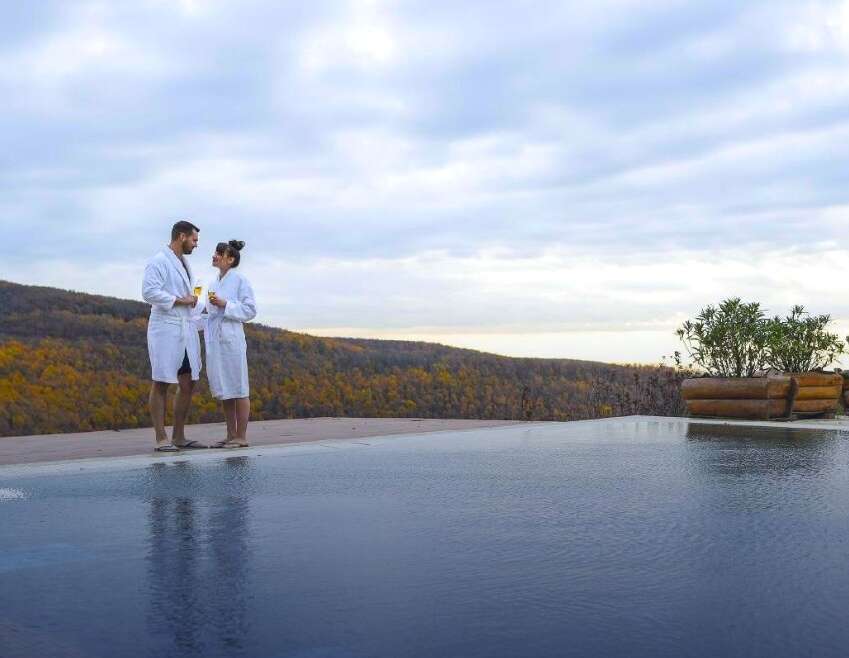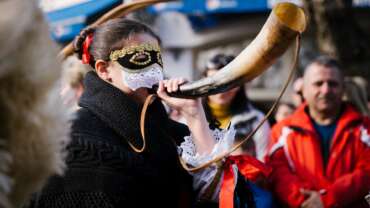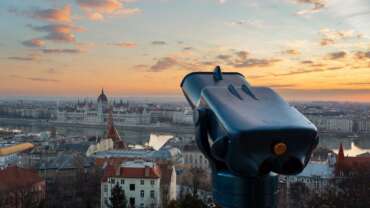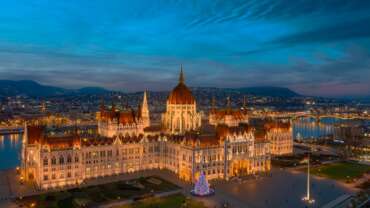Relax & Wellness in Hungary
“Pray for a healthy mind in a healthy body”, the ancient Roman poet Juvenal suggested. The curative powers of these waters were well known in Roman times. Nowadays, Hungary is a centre for health, medical and spa tourism. The country is extremely rich in thermal waters: it has nearly 1,500 hot springs and over 270 different types of mineral and medicinal waters. 80% of its territory has some kind of thermal water underground.
Thermal Baths & Spas
Did you know that there are approximately 1,500 mineral springs utilized in Hungary today? Although the standards are stricter here than elsewhere in the world, the country has over two hundred sources of water with a proven medicinal effect, allowing visitors to benefit from hydrotherapy and various other treatments.
The land of spa culture
The Ottoman occupation of Hungary was not confined to Budapest – a bathing culture was spread across Hungary.
A gleaming example of Hungary’s hammam heritage is Eger, 140 km east of Budapest. Here bathers soak beneath a golden dome built 400 years ago and renovated over time. The traditional octagonal pool and 200,000 pieces of gilded mosaic reflect an authentic ambience, enhanced by the foam massages and apple teas also available.
Down by the Romanian border, at Makó you can bathe in a church-like building designed by the acclaimed Imre Makovecz. His HAGYMATIKUM SPA hints at Hungary’s folk and pagan past, as well as Makó’s prime onions, hagyma. You can explore a tropical storm cave, play chess outdoors in winter and relax in medicinal mud from the Mures river.
By the Serbian border, THE CENTURY-OLD ANNA SPA in Szeged offers night bathing amid Neo-Renaissance architecture.
Hungarian spas can also heal. Those suffering from respiratory ailments can relax at TAPOLCA CAVE, on the north shore of Lake Balaton. With a high humidity of 14-16 degrees, regenerative ions and minimal dust, Tapolca has long been a healthy retreat. During World War II, the cave was used as a refuge by the hospital above. Patients saw their conditions improve, a benefit enjoyed by today’s guests at the nearby hotel, where active leisure is also encouraged.
In eastern Hungary, HAJDÚSZOBOSZLÓ is one of the largest spa centres in Europe. Also notable are the baths in Debrecen parkland, THE CAVE BATHS OF MISKOLCTAPOLCA and alfresco SÓSTÓGYÓGYFÜRDŐ BY NYÍREGYHÁZA. THE SALT HILL OF EGERSZALÓK merits a special mention, a large mound, naturally formed, around which a luxury resort has been built. The waters here are particularly salubrious. In the north-west of Hungary, the medicinal waters of Sárvár spring from two sources deep in the Earth and supply an extensive spa complex.
Further south, the unique CASTLE BATHS IN GYULA are set around a medieval fortress, the spa converted into a recreational area in 1970, 450 years after the Turks bathed here. The vast thermal spa at Harkány, much of it outdoors, can help with fertility and arthritic issues.
Budapest, the Queen of bathing cities
No other capital in the world has more hot-water springs. Whether for rehabilitation or recreation, it’s worth devoting some time to discover the city’s thermal baths. No visit to Budapest can be complete without a visit to its spas, which give the sense of stories from the pages of a history book coming to life.
Bathing in medicinal water and springs in the Hungarian capital has an over two thousand year-old history. The Romans established a flourishing bathing culture on this spot, which was enriched by further additions and numerous, still active facilities by the Turkish conquerors in the 15-16th century. The development of bath culture was made possible by the network of hot springs running under the capital city. The springs ranging from pleasantly lukewarm temperatures up to 77 degrees Celsius surge to the surface through over a hundred man-made wells and in several spots in natural form.
Budapest continued to shrewdly use nature’s gifts: a number of reputable baths were built in the 19th century, which have been renovated, one by one, over the recent years. You can see this for yourself when you visit the city, as the latest aquatic complexes suitably preserve these traditions. The beneficial effects of the springs can be enjoyed at 14 different spas. Additionally, the capital city with a population of 1.8 million offers the bustling scene of a real metropolis coupled with a range of wonderful architectural creations from various periods of history, impressive panoramic views of the Danube and a lively cultural scene.
Patina and art
Some of Budapest’s baths have an atmosphere that feels as though you were unwinding in a museum. The breathtaking complex of THE SZÉCHENYI THERMAL BATH lies in the City Park on the Pest side in a stunning location. With a flair of the Austro-Hungarian Monarchy, the building is a stately sight amongst the park’s lush trees – it looks more like a real palace than a bath. Water-lovers are treated to a total of 21 pools, three of which are outdoors. The sight of chess players in the pool during the day is just as common as the array of colours offered by the “sparty” musical bath nights.
Another unforgettable sight is THE GELLÉRT THERMAL SPA, nestled at the foot of the Buda Hills, situated in one of the loveliest stretches of the Danube. The halls of the nearly one hundred year-old secessionist building might seem familiar from a number of successful movies: its turquoise Zsolnay tiles, lead glass windows and statues have served as inspiration for countless artists in the past. The other favourite site of the art scene is the Lukács Thermal Bath, which features a wall of commemorative plaques of all the miraculous cases of healing that took place there.
Historical Turkish Baths
Another unique feature and historical value of Budapest are the original Turkish baths found throughout the city. Following its full-scale renovation, the 16th century Veli Bej Bath has been restored to its former glory. Make sure to study its incredibly detailed mosaic ornaments reminiscent of the art of the former Ottoman Empire.
Located at the foot of Gellért Hill, the nearly 450 year-old Rudas Thermal Bath has also been recently restored. Apart from experiencing the atmosphere of traditional Turkish baths, visitors can take in the stunning views of the Danube and its many bridges from the panoramic pool found on the top of the building.
Family experiences
Bathing in the centre of a global city on a lush green island surrounded by parks is just one of the unique experiences offered by Margaret Island in Budapest. Since 1919, this has been the site of the capital’s longest standing open-air swimming pool, the Palatinus. Today, the facility features timed giant slides and 14 pools, amongst other things.
Aquaworld, an adventure pool complex for families, is one of the youngest complexes of the city, located on its outskirts. The Southeast Asian Angkor ruins served as the inspiration for the bath’s impressive interior: the five floor high, gigantic dome houses a total of 4,000 square metres of water surfaces, including 15 different pools, 11 slides and dizzying rope-bridges that offer a multitude of engaging adventures.
World-famous stars in the pool
One might easily stumble across a famous person or two when visiting the prestigious GELLÉRT THERMAL BATH. The bath’s guests included the likes of Queen Juliana of the Netherlands, former US President Richard Nixon, composer Andrew Lloyd Webber, violinist Yehudi Menuhin, as well as world-famous actors such as Uma Thurman and Ryan Gosling.
Hévíz, Harmony for Body and Soul
There is a town located near the western tip of Lake Balaton with a name indicative of the local hot-water springs. Visitors in Hévíz (meaning: warm water) can go for a swim in the world’s largest, biologically active thermal water lake.
This is a site where archeologists have unearthed sacrificial medals of healing from the Roman period and where, according to legends, future Roman Emperor Flavius Theodosius was cured from his infantile paralysis.
The development of modern bath culture began in the 18th century, when the region was the domain of the famous Festetics family and Count György Festetics built a bath based on rafts.
A real miracle laboratory
The tens of thousands of years old lake reaches up a depth of 38 metres and has a surface of 4.4 hectares, serving as a nature reserve along with the 50 hectare forest surrounding it. The forest shielding the lake from its surroundings is a key element of the lake’s ecological system – the lake’s curative effect is fully complemented by its natural surroundings. Its biologically active waters are used for post locomotor-operation rehabilitation and to fight off the effects of gout as well as for the general preservation of health.
The lake’s water is naturally replaced every 3.5 days. The oval-shaped lake is fed by hot and cold water springs alike – its temperature during summertime varies between 33–38 degrees Celsius and will never fall below 22-23 degrees Celsius even in the winter, allowing visitors to comfortably swim outside in the lake even in the harshest weather conditions, covered by a thick layer of steam that usually surrounds the lake in such periods.
Come and share the unparallelled experience of taking in the views of the quaint old buildings with fully restored interiors from the water. The site features modern therapeutic departments, as well as a wellness and therapy centre, providing ideal conditions for recovery, rest and recreation.
Natural detoxification with the medicinal mud
The bottom of the curative lake is lined with a several metre deep layer of peat. Thanks to the special organisms living in the mud, the medicinal mud of Hévíz has a unique softness.
Treatments performed with the warm medicinal mud can stimulate circulation, leading to an accelerated metabolism. It makes the skin flexible and velvety soft, which is why the mud sourced from the lake is utilized by the beauty industry.
The over two hundred year-old therapeutic tradition, as well as the medicinal water with a special composition and the medicinal mud gained from this source are utilized in the traditional Hévíz therapy, which has scientifically proven beneficial effects. The premium category Hévíz therapeutic hotels as well as the wellness and medical hotels of the region offer classic therapies and modern wellness services alongside countless health preservation, fitness, selfness and lifestyle programs besides their own bathing facilities.
A wide range of active, cultural and culinary experiences are waiting to be discovered in the region. The parks, promenades and hiking trails are suitable for relaxing strolls or even Nordic walking.
Western Hungarian Bath Cities
Bükfürdő
Situated near the Austrian border, Bükfürdő has developed a name for itself over the recent decades amongst domestic and foreign patients alike who suffer from various locomotor disorders. The effect of the bathing and drinking therapy carried out with medicinal water with an exceptionally high mineral content – even in international comparisons (over 15,000 mg/l) – is second to none.
The generous, 14 hectare park and the modern Medical Wellness Centre offer a range of unique experiences. Services of the wellness centre can be accessed even without an admission ticket to the spa. Hungary’s second largest bathing complex features 34 pools and over 5,000 square metres of water surface, medicinal, swimming and adventure pools, modern sauna facilities and a wellness centre as well as a renowned therapeutic department and camping area for guests.
Come and experience the diversity that is sure to captivate all generations! An adventure pool with slides, a ‘shark cave’ and a playroom featuring a range of colourful toys await families with little children. At the wellness centre, adults can choose from ten different saunas; the bravest can alternate between the 100 degrees Celsius ‘Devil’s Shack’ followed by the ice cold air of the cryo cabin.
Sárvár
What does the town of Sárvár, steeped in history and situated in beautiful natural surroundings, halfway between Vienna and Lake Balaton, have to offer? It’s hard to find another single location with medicinal waters of two different compositions and effects, which infuse the body and wash away the troubles of day-to-day life.
One of these is a 83-degree Celsius, highly saline medicinal water, whilst the other measures 43 degrees Celsius and is rich in alkaline-hydrogen-carbonate. The former is recommended for treating gynecological inflammatory diseases, whilst the latter is used for muscle-relaxing baths, yet both medicinal waters are suitable for the treatment and rehabilitation of locomotor diseases. Thanks to the indoor pools, the spa is open for all ages, regardless of the season or weather.
The family adventure bath, featuring a wave pool and a baby pool filled with toys and giant slides is connected to the medical wing by a spacious corridor. This allows both children – spirited, yet undoubtedly loud – and those seeking tranquility and relaxation to share the two parts of the spa in peace. Apart from numerous pools, the medical treatments as well as the various wellness and fitness services are highly popular. The wellness facility features refreshing massages, from manager massages to lava stone massages, tub baths and packs and a nearly endless number of treatments.
Harkány
Situated in one of the most beautiful regions of Hungary, just a few kilometres from the Croatian border, the Harkány Thermal Spa has been serving the recovery of visitors for nearly two hundred years.
It’s located in a 13.5-hectare shady primordial park with nearly 8,000 square metres of water surface. According to legends, the sulfuric curative springs of Harkány burst to the surface on the spot where an angry devil vanished after being tricked by a wily old woman. Powers of the Harkány waters are confirmed by over 160 thousand successfully cured rheumatological, dermatological and gynecological cases.
The sulfuric Harkány medicinal water rich in minerals has been used to treat psoriasis for decades. There are only two other spots in the world apart from Harkány where psoriasis can be verifiably cured. Thanks to the medications supplemented with local mud, certain types of infertility can be treated here as well. The region’s special microclimate – with 2100-2200 hours of sunshine a year – also assists recovery and replenishment.
Northern Hungarian Bath Cities
Egerszalók
The 1,200 square metre limestone deposits of EGERSZALÓK are considered an iconic rarity the world over, with only two other sites with similar natural formations. The hot waters surging up from the deep found a way to the surface at this point, while the lime deposited on the hillsides created a shiny, white surface. The deposits keep expanding year after year: white limestone ledges, tiny lakes and lacy ledges and limestone curtains continue developing, which look lovely during the day, yet yield an even more captivating experience in special night-time lighting, providing a rainbow of colours to admire by hikers passing by or when bathing in the pool opposite the deposits. Let yourself be captivated by the sights!
The calcium-magnesium-hydrogen-carbonate waters that burst to the surface here have a significant sulfuric content. Visitors to the site typically include those coping with locomotor disorders or undergoing post-orthopedic or spinal operation rehabilitation; yet naturally, there are also a fair number of people who purely seek physical and mental refreshment. The sauna facility features beer, honey and salt sauna ceremonies as well as the first Finnish sauna log house of the country.
Miskolctapolca
The CAVE BATH OF MISKOLCTAPOLCA is a unique attraction of Europe that features a spa installed in a cave formed over thousands of years. Visitors to the cave can bathe in naturally formed caves and halls, while taking in the echo of the so-called Stars’ Hall and enjoy the pleasant massaging effect of the currents.
The refreshment of body and soul is guaranteed by the pleasantly warm thermal water surging up from the depths of the mountain as well as the clean cave air free of impurities. Those seeking wellness experiences can choose from a range of various saunas, a float spa and the services of the aqua-therapy facility featuring a combination of traditional folk practices and modern technology, thus mitigating the exhaustion caused by day-to-day stress. Apart from the cave, a nearly 3.6 hectare park and accessibility area features six additional pools to ensure the recreation of the visitors to the cave bath.
Eastern Hungarian Bath Cities
Nyíregyháza
The nearly 400 hectare key nature preserve of the Sóstó Spa with exceptionally clean air, functioning as a resort of NYÍREGYHÁZA, is situated in the northeastern region of the country, surrounded by the Sóstó forest, named after its salty, alkaline lake.
Visitors are not simply welcomed by a complex: it includes an adventure pool, lake pool and the still functional building which originally served as the hub of the local spa scene in the 1700s with a total of four giant oak tubs. When visiting the Aquarius Adventure Park and Spa, visitors can experience how the latest devices serve their comfort – including balneotherapy procedures and physiotherapy treatments that guarantee recovery. Members of the older generations can regenerate in outdoor and indoor thermal water pools, while the young can experience the adventure park equipped with a wave pool.
A white water drift pool and various giant slides are also there to provide an adrenaline rush. The youngest visitors can have fun in three pools of varying depths, along with a treasure island and ‘the ruins’ of an Incan temple.
Hajdúszoboszló
Hajdúszoboszló offers a fine pastime all year round for young and old alike, with the largest bathing complex in Europe and a real four-season, aquatic adventure centre with well-partitioned sections.
The AQUA-PALACE ADVENTURE SPA features a sauna facility, children’s adventure area and wellness experiences for all. Family recreation is ensured by a range of thematic pools reminiscent of various periods and cultures – including the unforgettable experience of indoor surfing.
The Aquapark is also a paradise for the lovers of giant slides, featuring a thirty-hectare swimming pool with adventure, swimming, wave and children pools, jacuzzis and even a “Mediterranean beach”. The classic thermal spa featuring medicinal water with a temptingly unique composition offers forty different treatments and visitors can even taste the spa’s own mineral water.
Debrecen
Debrecen, the second biggest city of the country is located only twenty kilometres to the northeast. NAGYERDŐ – literally meaning great forest – is a merely ten-minute walk from the city centre, offering comprehensive recreation under century-old trees.
The Aquaticum is found in the heart of the area, which is capable of conjuring up the heat of the summer even in the cold winter months, where adventurous guests can race down giant slides surrounded by lush, tropical vegetation, while families with young children can enjoy the baby-friendly facilities, including a baby-mother rest area and a chlorine-free baby pool. Naturally, the site also offers a classic therapeutic facility, a wellness department and a sauna facility.
The therapeutic department offers traditional bathing treatments as well as a wide range of physiotherapy and exercise – over forty treatments in total based on medicinal water.
Gyula
What truly sets THE CASTLE SPA OF GYULA apart from other sites is that it’s located in magically historical surroundings. There is no quainter spa town in Hungary than Gyula, where the whole family can have fun. The characteristic, brownish local medicinal water is recommended for mitigating locomotor, neuropathic and dermatology complaints.
Apart from the thermal water pools of various temperatures and a wide range of balneology services, those seeking active recreation can do laps at the competitive swimming pool, whilst the wellness facility is open even on Friday and Saturday nights.
A few years ago, the complex was expanded with the Aqua Palace, a new family adventure pool open throughout the year, featuring two giant slides, a light corridor and a downward-sloping swim ring slide and countless other aquatic adventure elements that provide real fun for all members of the family.
The Cave Bath of Miskolctapolca
Indulge yourself in north-east Hungary’s nature-carved cave bath. Miskolctapolca is a resort with a special microclimate in the southern part of Miskolc, offering a chance to recharge your batteries, with a boating lake and healing thermal water welling up from the depths of the mountain.
The water carved out the cave system – now transformed into a bath – from the hard limestone over millennia. The pools inside the caves are perfect for relaxing all year round. In fact, thanks to the warm karst water from the depths of the mountain, winter bathing may be even more refreshing. This is your chance to take part in an experience normally reserved for trained cavers when they discover a cave – but they have to wear protective gear while they do so. The cave pools have been formed in natural passages and halls, with underwater jets at the bottom to massage guests. A little further away, moving against, or possibly riding the current of an “underground river” moved by a hidden structure, you can get to the swimming pool of the oldest excavated, most beautiful cave section. Swimming in passages that are hundreds of thousands of years old, a pleasant tingling feeling pervades your body, as the wild water currents under the surface gently caress you.
From here you reach the Star Hall, where it feels as though you’re swimming under the starry sky. You’ll enter a meditative state, while listening to the mysterious echo of the Star Hall, or simply admiring the special shapes of this rare natural phenomenon. By the way, this thermal water is less dense than other healing waters, which is why many prefer it: you can stay in this water as long as you like and try the magnificent kneading and other water attractions. This also allows children to paddle along with their parents all day. So it makes no difference whether you’ve come to rejuvenate or revitalise, for preventive or healing purposes or to play together: everything is possible here. The 30°C water and the climate of the cave both have a healing effect and are particularly recommended for degenerative joint diseases. Rheumatic and musculoskeletal problems are treated in a pleasant environment and a familiar atmosphere. Balneo- and aqua-therapy are a long-standing tradition here. In addition to healing and thermal pools, visitors looking for more of a sense of freedom can choose from several outdoor pools. The cave is a masterpiece of nature, but the lake pools and the gracefully elegant shell roof leaning over it are a tribute to human creativity.
One of the most relaxing place in Hungary
But you’ll also find a children’s pool, a lake spa experience, a swimming pool and a sauna park. In the latter, guests looking to relax, refresh and detoxify have a choice of three lava-stone Finnish saunas, three infrared saunas and a steam cabin. After the sauna, you can cool off in the 16‑18°C plunge pool. The ruins of the Benedictine monastery built in the 13th century are visible at the entrance to the Cave Bath. Monks lived here from the second half of the 14th until the beginning of the 16th century. The abbey suffered several attacks over the years, until finally members of the order fled. The abandoned buildings were destroyed, after which the area became a swamp. In 1711, the abbot of Tapolca had doctors brought from Košice to prove the healing effect of the water and the area. The description of the wooden bath building dates back to 1743, so the bath was definitely completed by then, but Miskolctapolca only truly became a resort area in the 1920s and 30s. As you can see, neither winter nor summer exist at the Cave Bath. Spring rules eternal in the cave passages, whether it’s sweltering hot or bitterly cold outside.
The exciting Avalon Park
Avalon Park, including the Maya Play Park, as well as an electric go-kart track offer high-standard entertainment in the region. An assortment of safe equipment for agility, climbing and jumping, as well as slides, ensure that kids of all ages will have fun at the play park. Entering the play park, children forget about time altogether and become completely engrossed in playing. For young adults, the tree-lined electric go-kart track at the HELL Kart & Event Centre offers a suitable programme with ferocious speeds for technical sports enthusiasts. If, however, you’re obsessed with active leisure, choose the tracks of the nearby adventure park, where you can test your skills on a blue, a red and a black route. Come and dip into the experiences available at the Miskolctapolca Cave Bath.
The Gyula Castle Spa, where everything is in place for a peaceful and relaxing time
A beautiful park with ancient and primeval trees, thermal water known far and wide, a waterpark and a sauna world: all these await you at the Gyula Castle Spa.
The water at THE GYULA CASTLE SPA is considered to be of particularly high quality, even in Hungary. It was declared to be medicinal water in 1968, and since then it has attracted an ever-growing number of visitors who come to have their illnesses cured and enjoy some rest and relaxation. The spa is located in an enchanting environment, the 8.5 hectare park of Almásy Castle, with its ancient and primeval trees. Enjoy the frolicking and fun offered by the outdoor pools, including the wave pool and slides. If you are ready to work your muscles, just dive into the cool water of the 25-metre indoor training pool or 50-metre Olympic pool. The Aqua Palace has been part of the facility since 2013, and it is a true water paradise in the Castle Bath, with a wide range of pools with fun features and slides. Anyone who loves saunas should definitely try the Castello Sauna Park, where three outdoor sauna houses, outdoor hot-tubs, cold water tubs, wooden bucket showers, two indoor infrared saunas and steam cabins have been installed for guests to enjoy. The medicinal unit of the Castle Bath has pools with medicinal water of varying temperatures, but also offers guests different types of treatments.
Heal yourself in Gyula!
The wonderful environment and an entertainment centre that meets everyone’s needs, together with the medicinal water, make the Gyula Castle Spa a very attractive destination. The brownish thermal water contains alkali-hydrogen carbonate-chloride and is expressly recommended as treatment for musculoskeletal conditions, neurotic complaints and gynaecological, inflammatory conditions. There are four pools of different temperatures, and you can choose from a wide variety of treatments. Tub bath with medicinal water, weight bath, carbonated water treatment, underwater jet massage/tangentor, underwater physiotherapy, swimming classes and other physiotherapy treatments are all available in the bath.
Békéscsaba also has a bath with a long history
The Árpád Spa and Pool Complex is located in the centre of town, near the Élővíz Canal. The spa has pools with thermal water that is recommended for the joints, musculoskeletal and rheumatic conditions, while the outdoor swimming pool and the training pool are open all summer and people come from places far away to take a splash and relax.
Medical Tourism
“Medicus curat, natura sanat” – The physician treats, nature cures. Come visit us and experience Hungary’s unique medicinal waters and medicinal mud. Discover our mountains and caves suitable for climatic therapy and find out what wonderful healing powers certain gases have. The country’s natural treasures provide for the revitalization of body and soul in an unparallelled way.
Medical treatments
Hungary is outstanding in several ways when it comes to medicine and medical science, which you can experience yourself if you visit the country. The country is at the forefront of diagnostics, dentistry, ophthalmology, orthopedics and plastic surgery. The leading Hungarian institutes provide services at a high level of quality: the physicians and nurses are highly skilled and the offices are technologically fully developed
Dentistry
Hungary is one of the dentistry hubs of Europe. Beyond the capital, Budapest, dental offices in cities along the western border including Sopron, Mosonmagyaróvár and Győr provide foreign guests with high quality services. Patients leave Hungary fully satisfied: they’re serviced by skilled dentists, accommodating teams and offices featuring cutting-edge technology.
Diagnostics
While other countries have long waiting lists, various diagnostics procedures are available quickly and at a favourable price – including the device-based examination of the heart, ultrasound or mammography services.
Orthopedics
The Hungarian orthopedics clinics look back on decades, or sometimes a half century-long history in treating patients with locomotor disorders – in fact, they also perform high-level research activities.
Apart from the quality of medical care, patients can also spend the period of rehabilitation amongst the best conditions, thus allowing visitors to even undergo such complex procedures as mosaicplasty knee surgery and hip surgery.
Highly skilled physiotherapists and masseuses assist recovering patients in renewed surroundings with top quality instruments.
Aesthetics
Hungarian plastic surgeons can only start working after at least 13 years of internship, therefore their preparedness is unquestionable. All the trendiest procedures requiring the latest technical devices are available in Hungary at favourable prices. Accordingly, the services range from skin-tightening and rejuvenating procedures, phototherapy, ultrasound facial rejuvenation, Infini treatment, as well as laser hair removal, weight-loss treatments and traditional plastic surgery procedures.
Infertility
Hungarian health institutions have a good success ratio of helping couples facing infertility. The services include in-vitro fertilization treatments and various forms of artificial insemination as well as gynecologic and male infertility evaluations, hormone determinations, hysteroscopy and hystero contrast sonography examinations.
Ophthalmology
Since the 19th century, Hungarian ophthalmology has provided medical science with a number of renowned experts. The eyelid ptosis and loxophthalmus surgeries of László Blaskovics were considered ground-breaking, whilst later on, Aladár Kettesy invented numerous key surgical procedures and created new ophthalmology devices. In August 2008, Dr. Zoltán Zsolt Nagy performed the first femto laser-assisted cataract surgery in the world.
The treatments begin with the examination of the complaints and various screening tests, followed by the cataract surgery, contact lens implantation, pterygium surgery, fibroma, stye and atheroma removal and can be concluded with double blepharoplasty surgery. It’s also worth visiting the country for cutting-edge corrective eye surgery.
Healing natural resources
Invigorating Water
Did you know that there are approximately 1,500 mineral springs utilized in Hungary today? Although the standards are stricter here than elsewhere in the world, the country has over two hundred sources of water with a proven medicinal effect.
Medicinal Mud
Mud as warm as 36-42 degrees Celsius is used for the packs. The active agents are absorbed through the skin, stimulating nerve endings – thus producing a muscle-relaxing and pain-relieving effect. As opposed to pain reliever medication, the treatment has a long-lasting effect, easing pains and aches for up to several months.
Climb That Mountain
Cool mountain breezes await with lower air pressure, which can facilitate the treatment of heart and circulatory conditions and high blood pressure, and is also recommended for bronchitis and certain metabolic disorders. Kékestető peak in the Mátra Mountains is one of the country’s most renowned high-altitude climatic health resorts.
Take a Deep Breath
Based on therapeutic climatic effects, cave therapy can also yield improvements in the case of various respiratory diseases. Soluble minerals in the water dripping from the ceiling and walls of the caves have an anti-inflammatory and anticonvulsant effect when inhaled. There are five certified medicinal caves in Hungary: the Abaliget cave, the István Cave of Lillafüred, the Szemlő-hegy Cave of Budapest, the therapeutic cave of the city hospital in Tapolca and the Béke Cave in Jósvafő.
Up to the waist in gases
A long time ago, after dangling their legs off the edge of a cavity, someone noticed that the injuries on their feet were beginning to heal. The answer lies in carbon dioxide. As a post-volcanic feature, gases are found flowing from certain spots in the world, which have a therapeutic effect in the bloodstream when inhaled or absorbed through the skin. Naturally, there’s no need to dangle your legs over a cliff, but rather the gas is administered as a treatment in a controlled environment.
In the Northern Hungarian village of Mátraderecske, medicinal gases with a high carbon dioxide content erupt from a depth of approximately 1,000 metres, recommended for heart and circulatory rehabilitation and also recommended due to its high concentration of radon for arterial diseases and peripheral artery disease tied to diabetes.








